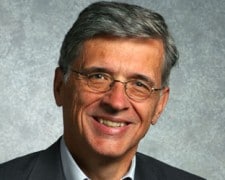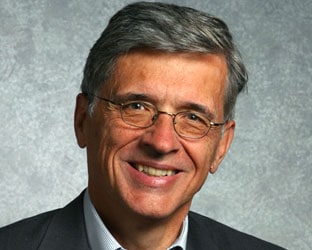The former CEO of the Cellular Telecommunications & Internet Association went back to his roots last week to help foment a revolution.

Speaking Sept. 7 at the CTIA Super Mobility Show 2016 in Las Vegas, FCC Chairman Tom Wheeler took a cue from Randy Bachman when likening 5G to “the missing piece of the puzzle depicting the wireless future.”
He notes, “When I stood on this stage years ago, I was constantly saying, ‘You ain’t seen nothing yet.’ Well, pardon me for being repetitive, because here comes 5G.”
Where today’s wired and wireless networks “force” customers to choose either high speed and capacity or mobility, Wheeler says that 5G’s promise of gigabit mobile connections at any location “will open up hugely disruptive new value propositions for the users of networks.”
Wheeler applauded the “investment of hundreds of billions to deploy almost ubiquitous wired and wireless networks,”and the internet’s open design, which is protected by FCC rules, for allowing the freeform of ideas without asking for anyone’s permission.
Asking the CTIA crowd during his Sept. 7 keynote address what’s “still missing,” Wheeler said, “What is the biggest remaining constraint on that ‘Vision of the Wireless Future’ we used to talk about? Ultra-high-speed, high-capacity, low-latency, secure mobile connectivity. That’s what 5G delivers. As this industry proved when it removed the network limitation of having to be in a fixed place, removing network limitations opens up exciting uses. And now the limitations of speed, capacity and latency are about to become history.”
Wheeler then asked, “What do we need to do seize the 5G opportunity?”
The answer, he says, starts with competition.
“With four nationwide carriers, the U.S. wireless industry continues to invest in faster, better networks with $33 billion invested last year and nearly $100 billion invested over the past 3 years,” he says. “That’s over and above the investment of billions in spectrum acquisition.”
New services and applications are constantly being introduced and consumer demand seems insatiable, he adds. “Wireless data use more than doubled from 2014 to 2015, and continued growth is projected for the foreseeable future,” he says.
There are three keys for what the Commission can do to help unlock the 5G opportunity, Wheeler believes:
- ensuring ample availability of spectrum to a range of competitors
- taking all steps to foster competitive provision of infrastructure
- removing unnecessary hurdles to siting.
“In all these areas, the FCC has activities underway,” Wheeler says. “Yet, let’s be realistic, there is more to be done if 5G is to realize its promise.”
During the summer, the FCC approved an order making the U.S. the first country in the world to open up high-band spectrum for 5G networks and applications.
“In order to give this industry the opportunity to lead the world in 5G, we did it in record time—only nine months from proposal to final decision,” he notes. “We are also going to keep the pedal down on making more high-band spectrum available for 5G. And, while we are busy putting out new spectrum, we will facilitate experimentation and innovation – by soon launching our electronic filing system to accept applications for program experimental licenses. Experimental licensing has led to countless wireless innovations through the generations of wireless technologies. The new program licenses will provide much greater flexibility for researchers, universities, OEMs, and other innovators to conduct experiments and field tests of 5G technologies at scale.”
The issue of an expanded number of cell sites brought Wheeler to discuss a third 5G challenge: siting.
“That’s hundreds of thousands, maybe even millions of new antennas,” Wheeler says. “That’s hundreds of thousands, if not millions of siting decisions. This raises quite a few questions: What can government do accelerate investment in building out small cells? How can federal, state, and local levels of government work more effectively with the private sector? Or to take it down to real brass tacks, how can we work with siting authorities to allow the plethora of antennas that will be required quickly and at a reasonable cost?”
His response?
“We have to help leaders at the local level – and all levels for that matter –understand that 5G will make the Internet of Things real … Let’s talk about the benefits of smart-city energy grids, safer transportation networks, and new opportunities to improve health care. Let’s paint the picture of how 5G will unleash immersive education and entertainment industries, and how 5G will unlock new ways for local employers to grow, whether it’s a small specialty shop or a large factory, creating new jobs and improving services for the community. 5G is not a technology — it is a revolution.”





